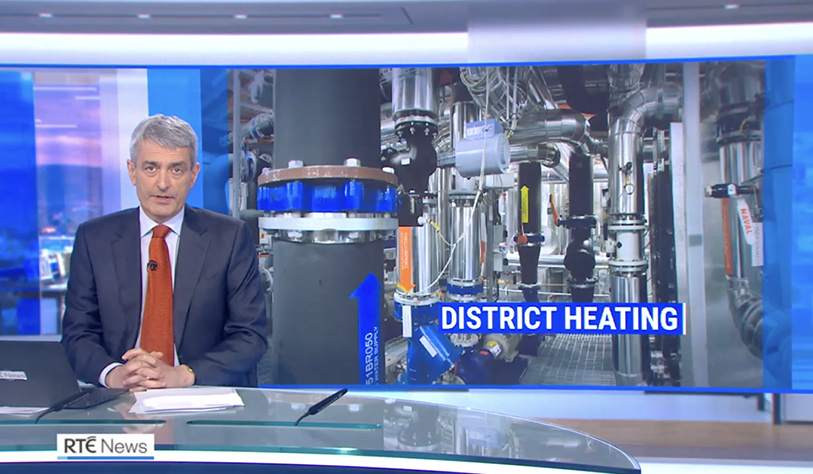TU Dublin Tallaght campus becomes part of Ireland’s first low-carbon District Heating Network

TU Dublin is delighted to be part of Ireland's first low-carbon sourced district heating system, with our Tallaght campus part of an innovative, low-carbon initiative led by South Dublin County Counci
The not-for-profit Heatworks district heating network will initially provide heat to 32,800 m² of local public buildings at TU Dublin and SDCC, expanding to heat 133 affordable apartments in 2025. Heatworks uses excess heat from a nearby data centre to provide low carbon heat to customers. TU Dublin buildings to benefit on the Tallaght campus include the Main Building, the Sports-Science, Health, and Recreation Building, followed by a new multi-disciplinary building for teaching and research in hospitality, culinary arts, engineering, and apprenticeship activities, which is to be completed in 2024.
Speaking of TU Dublin’s partnership with the network, TU Dublin’s Vice President of Partnerships, Thomas Stone said:
Partnering with Ireland’s first publicly owned, not-for-profit energy company, Heatworks, is of significant value to TU Dublin and to the project partners on the District Heating Network. This collaboration provides a live testbed demonstrating how the by-product of energy intensive datacentres can be redistributed to provide low-cost and low-carbon heat to users locally including the public sector, residential, and commercial customers. There is significant potential for district heating development in the Dublin region. As a first in the Irish market, this system will also offer TU Dublin researchers the chance to study replicability and give students the opportunity to develop new urban services and products and the skills necessary to prepare for engagement in this emerging industry.

What is district heating?
District heating is a form of energy infrastructure where both space and water heating is provided to a local network of buildings from a central energy plant. Through steam or hot water produced at the plant, district heating systems transmit constant heat through a network of insulated underground pipelines to local buildings. By transferring thermal energy to a local building’s heating system, partners on the network avoid the need for boilers to heat their space and water. The benefits of district heating include lower infrastructural installation and maintenance costs for customers and greater efficiencies in transitioning to lower carbon energy for heating. Because district heating is flexible and technology agnostic, it allows a better uptake of renewable energy at a large scale. The National Heat Study has identified that district heating has the potential to provide as much as 54% of building heat demand in Ireland.
Recycling waste heat from data centres
In 2028, 29% of all electricity demand in Ireland will come from data centres. Operating data centres is energy intensive, however, there is great potential to reduce the carbon impact of these facilities by recycling the waste heat which is constantly generated from them.
The local Heatworks Energy Centre in Tallaght uses excess heat from the nearby Amazon Web Services’ (AWS) data centre to provide low carbon heat to customers on the Tallaght District Heating Network. AWS has included heat-collection systems in their new facility which provides this recycled heat at no cost as part of its broader sustainability commitments. Heatworks contracted Fortum, a large Finnish energy company with extensive district-heating experience throughout Scandinavia and Eastern Europe, to carry out the design, construction, operation, and maintenance of the Tallaght District Heating Network.
Supporting Ireland’s emissions reduction targets
Under the National Climate Action Plan 2023 targets, Ireland is committed to reduce greenhouse gas (GHG) emissions by 51% in 2030 and reach net zero by no later than 2050. Investing in renewable and green energy is one of six vital, high-impact decarbonisation measures which will help Ireland achieve its emissions reduction targets. Within the energy sector, to achieve these ambitious targets, we must reduce the use of all fossil fuels, including coal, natural gas, oil, and peat to heat our buildings. By 2050, all residential, public, and commercial sector buildings will need to switch to non-fossil fuel based thermal heating systems, meaning that the gas grid will no longer supply existing homes and commercial premises.
The Tallaght District Heating Network was partly funded by the European Union's Interreg NWE programme (Heatnet), Project Ireland 2040 Climate Action Fund, SEAI and through direct funding from SDCC. In the Governments Climate Action Plan 2023, the increased ambition is that Ireland will reach up to 0.8 TWh of district heating by 2025 and up to 2.7 TWh by 2030.
Speaking of the initiative, TU Dublin’s Vice President for Sustainability, Jennifer Boyer said:
TU Dublin was delighted to commit to Ireland's first low-emission district heating network, at an early stage of the initiative. In support of the national strategy to reduce carbon emissions, we are implementing plans to provide a minimum of 70% renewable space heating at TU Dublin by 2030. Having received the first lower carbon heating supply in February 2023, the Tallaght District Heating Network is accelerating TU Dublin’s progress towards our 2030 decarbonisation targets.
It is estimated that in this first phase of the Tallaght District Heating Network delivery, the carbon emissions reduction in the Tallaght area will be over 1,500 tonnes per year.

